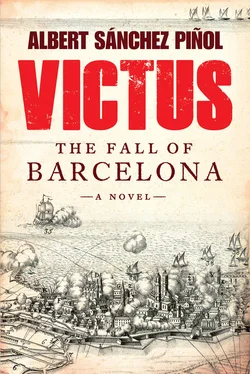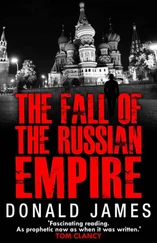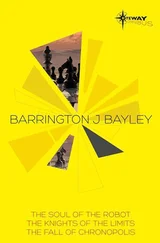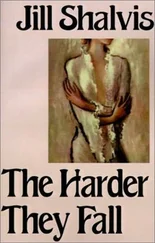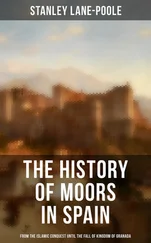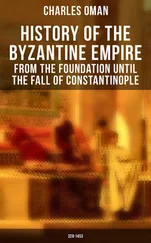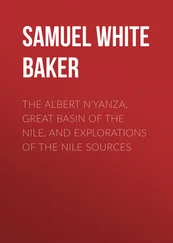Zúñiga didn’t laugh, not even a little. “Rather than refuting my argument, you strengthen it. Because the reason for being a man of letters is to convey lofty thoughts, and to do so in a style that elevates the language. What you have there is something quite different: pages filled with cudgelings and frivolity. Is that what the writers’ art should be devoted to?”
“Literature can, and indeed should, teach us lessons that, in its majesty, only it is capable of imparting. If someone says, ‘There is clarity in madness!’ well, wise words, but also no more than baseless opinion. But when this idea is presented to us plotted out within a dramatic framework, I have no choice but to agree.” I shook the thick volume with both hands. “Yes, that’s the great truth within this story: that reason is to be found in the irrational.”
The day after this literary debate, it was Stanhope and his cavalry ponies that took the role of protagonists in our current tale. We found ourselves on the outskirts of a little town called Almenar. Day was nearly done, and we were readying ourselves to spend the night on the outskirts of the village when word began to spread that the Allied army had met the forces of the Two Crowns. I suggested to Zúñiga that we go on ahead a bit to see what was happening. We left the civilian caravan behind. We came across the sick wagon in the rearguard, and when we asked them what news, they gestured eastward. “They say Stanhope’s surprised the Bourbons.”
I told Zúñiga I thought we ought to climb a little nearby hill, to watch what was happening.
It was a good walk. To tell the truth, we went because we had nothing else to do. And with the sun already setting, at this time of day, the climb would not be so wearying. It was an ocher-colored hillock, dappled with clumps of rosemary. The smell was wonderful.
Our summit was modest in height, but the views from it were good. A rectangular plane stretched out at our feet, flanked by mountains to the left and a river to the right. On one of the shorter sides of the rectangle was In-a-Trice Stanhope with his horsemen. A single regiment, in battle formation, occupied a space of some two hundred feet. In-a-Trice had arrived in Spain with four thousand strapping lads, selected for their fearsomeness. When not drinking or riding, they were pissing away their “bir” (a drink they spell “beer”), so the Catalans ended up calling them pixabirs , which is to say, “piss-beers.” And on the opposite end of the rectangle was the Bourbon army. Their infantry had been hurriedly arranged in a line, and their bayonets were fixed. God, what a great spectacle it is, to see thousands of men in formation and poised for battle. And yet, schooled as I was in the arts of Bazoches, I could sense something more than flesh and uniform. Amid that whole human mass, arranged as it was by battalion, I could make out their souls, like the little flames of thousands of candles trembling before the breath of an approaching hurricane.
I remember Zúñiga speaking the thought that was then running through his head: “Dear Lord, how is this going to end?”
In my day, the theorists of cavalry were engaged in a debate that ran curiously in parallel to that between us engineers. They, too, were divided between Vaubanians and Coehoornians, as it were, their Coehoorn being Marlborough. Yes, yes, the very same, Jimmy’s cousin: Malbrough s’en va-t-en guerre, mironton, mironton, mirontaine .
Up until that point, a cavalry had always followed the most prudent tactics. The riders would approach the enemy infantry, stop at the distance of a pistol’s range, and fire. Persistent gunfire could cause the infantry to lose its nerve and run. Then, and only then, would the cavalry draw their sabers to pursue the soldiers as they scattered in all directions.
These formations, which were sly and always had the chance of getting away entirely unscathed, were changed by Marlborough. Essentially, what he proposed was to go back three hundred years in the art of military cavalry, saying: Wasn’t the horse itself a hugely powerful weapon? Marlborough took the cavalry back to the Middle Ages: the horse seen not as transportation but as a means of crushing whatever was in its path.
The English cavalry was the first to take on this new tactic. When they came to within three hundred feet of the enemy line, they did not stop: They shifted up from a trot into a charge. They trampled anything that was in their way — problem solved! And — in a trice!
Let’s see whether you can guess, my foul little German, which of the two theories In-a-Trice Stanhope subscribed to? Bravo, you guessed! How very clever you are!
The sun was already sinking below the horizon, an orange semicircle surrounded by a violet halo. The great mystery is why the Spaniards did nothing. By the time Zúñiga and I reached the hill, the two sides had already been engaged for quite some time. The Spaniards had had hours to change formation or even withdraw from the field. But they did nothing, they did nothing of anything, at all. They just waited, melting under a summer sun. Perhaps the valley was too narrow for them to maneuver; perhaps they did not know of the tactics used by the English cavalry and thought that the riders would do no more than harass them a little with pistol and rifle. Or perhaps it was just the usual: The Spaniards were led by a pack of incompetents.
We could see the Allies on a bit of headland setting up a battery of six cannons. They began to fire at once, clearly meaning to support the charge of the cavalry. Stanhope had split his forces into two lines. When the order was given, the front line would charge, sabers in the air and howling hoarsely like wolves.
Believe me when I tell you there are few things in life more terrifying than a cavalry charge at twilight. Thousands and thousands of hooves, rumbling heavily against the ground in a multitudinous animal rush; the shaking was so great that, even where we were standing, stones and clods of earth were dislodged and went tumbling down the hillside.
By that time the Bourbon army had been severely diminished. At the start of the year, the French troops had returned to their country as reinforcements for the front at the Rhine, and the Spanish recruits left a great deal to be desired. In any case, you didn’t have to be a general or know the weaknesses of the Army of the Two Crowns; you only had to look at that mass of red coats on horseback headed toward the fragile line of little white soldiers, and it was obvious how the affair was going to end.
The Spanish lines quivered like strings of sausages, however much the officers ranted and raved, demanding order. They hesitated. Poor lads. Recruited not four days earlier, they were about to experience a charge from the elite of the English army. I did a quick calculation: four thousand horses, about three hundred kilos per head, plus an average of sixty for each rider, came to a total of over a million four hundred thousand kilos, racing forward at twenty miles per hour against some poor petrified boys. A moment before the impact, I looked away.
In some places, surprisingly, the upthrust bayonets did offer resistance. In others, the formation toppled like an old fence. Even the noise made you think of thousands of timbers splitting. And yes, despite the decisive violence of that clash, I learned one lesson on the field of Almenar, one I often repeated: that most retreats, curious though this may be, begin in the rearguard.
From that moment, the battle was reduced to no more than a human hunt. To a cavalry soldier, there is something magnetic about a back turned to flee. Instinct urges him to go in pursuit and split open the skull with a saber. As for the man being pursued, there are no words to describe the torment of his flight. If the saber doesn’t get him, the horses’ hooves will.
Читать дальше
